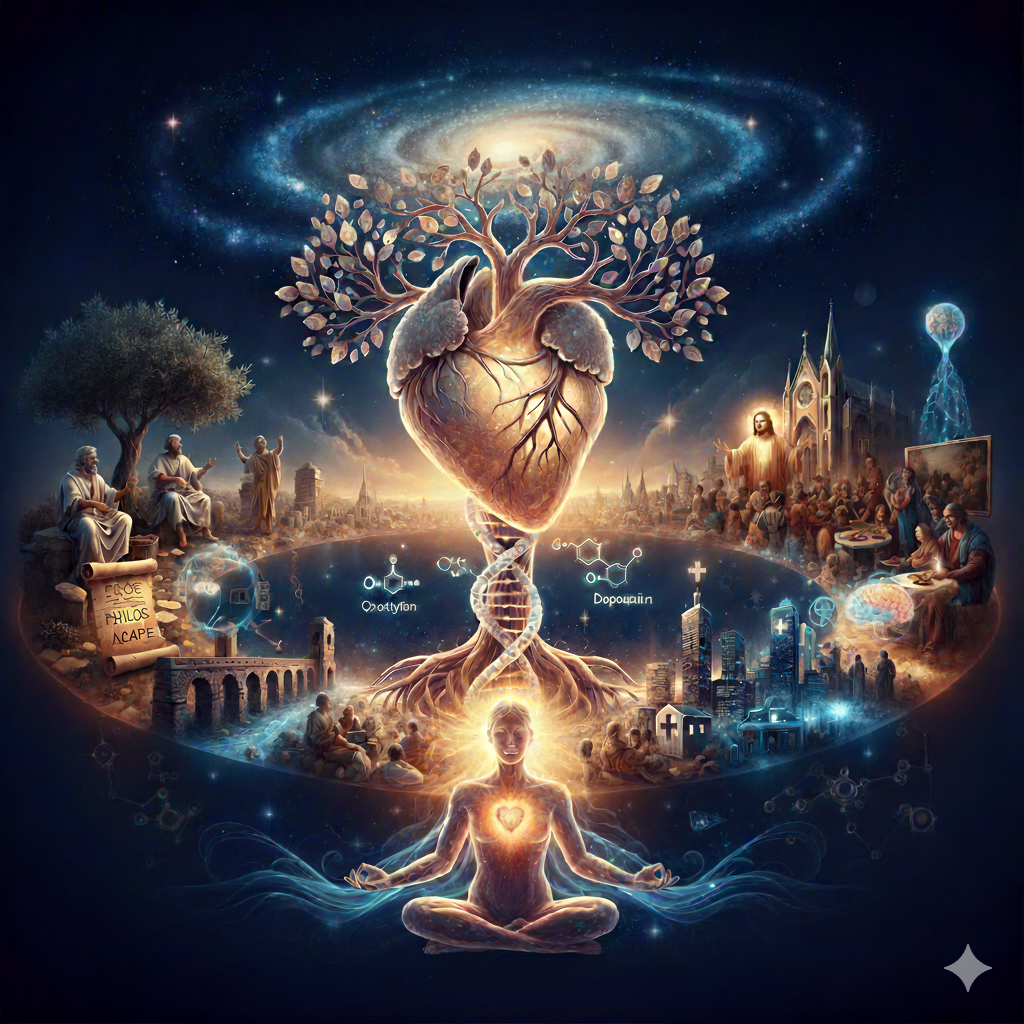Love, that driving force that propels life, transcends simple emotion. It is a multidimensional concept, studied by philosophy, explored by science, and, most importantly, elevated to the supreme principle by spiritual traditions. Understanding the breadth of love—in its diverse manifestations and evolutions—is to unlock the deepest purpose of human existence.
Table of Contents
- The Multiple Types of Love: Eros, Philos, and Agape
- Historical Timeline: The Evolution of Love, Religions, and Charity
- Before Christ (B.C.): The Roots
- After Christ (A.D.): The Agape Revolution
- Middle Ages and Renaissance: Love, Dogma, and Philanthropy
- From Modernity to the Present Day: Science, Reason, and Global Connection
- The Interdisciplinary View of Love and Goodness
- Science and Neuroscience: The Chemistry of Connection and Well-Being
- Philosophy and Medicine: The Impact on Integral Health
- The Understanding of Love and Charity in the Light of Spiritism
1. The Multiple Types of Love: Eros, Philos, and Agape
The Greek language, rich in nuances, provided us with distinct terms to describe the varied forms of loving, indicating that “love” is not a monolithic feeling.
| Type of Love | Meaning and Human Understanding | Spiritual Expression (Jesus and God) |
| Eros ( |
Romantic Love, Passion, and Sexual Desire. Seeks union and completeness in the other person. It has an intense and often conditional character. | Although not the central focus of Jesus’ teaching, marriage and respectful affective union are seen as the basis for the family, the fundamental unit of society. |
| Philos ( |
Fraternal Love, Friendship, Companionship. Based on affinity, common interests, and reciprocity. It is the virtuous and dispassionate affection, essential for social life. | Represents “love of neighbor” in the sense of esteem, respect, and mutual support among disciples and the community. It is the love between brothers and sisters in faith and humanity. |
| Agape ( |
Unconditional, Pure, Disinterested, Sacrificial Love. It does not seek its own interests and extends to everyone, including enemies. It is the highest form of love. | It is the essence of Jesus’ teaching (“Love one another as I have loved you”) and the very nature of God, who loves His creatures perfectly and eternally, being the source of all creation and mercy. |
Note: There is also Storge (), the natural affection among family members, especially parents and children, complementing the Greek view.
2. Historical Timeline: The Evolution of Love, Religions, and Charity
The concept of love and its practice in the form of charity evolved alongside human consciousness.
Before Christ (B.C.): The Roots
- Primitive Antiquity: Love was strongly linked to the survival of the clan or tribe (Storge and rudimentary forms of Philos). Charity, although present, was limited to the social group.
- Ancient Civilizations (Egypt, Mesopotamia): Ethics and justice began to define the relationship with one’s neighbor. Divine love was often associated with fear and obedience.
- Ancient Greece (6th to 1st centuries B.C.): Consolidation of the concepts of Eros, Philos (friendship as the supreme good, as in Aristotle), and the Platonic search for the Beautiful (an ascension from physical Eros to ideal and intellectual love). Charity was expressed as benevolence and a sense of civic duty.
- Judaism: The Mosaic law establishes the commandment: “Love your neighbor as yourself” (Leviticus 19:18), an expanded form of Philos, based on the covenant with God and justice.
After Christ (A.D.): The Agape Revolution
- 1st Century A.D. – Beginning of the Christian Era: The coming of Jesus Christ elevates Agape to a central principle. Love of God and unconditional, universal love of neighbor become the foundation of the new morality. Charity is no longer just a civic duty or an exchange, but the practical manifestation of this love, with an emphasis on aiding the marginalized and on humility (“do not let your left hand know what your right hand is doing”).
- Apostolic Period and Roman Empire: The practice of charity and Agape by Christians, even under persecution, becomes a social differentiator, attracting new adherents and organizing the first forms of social assistance.
Middle Ages and Renaissance: Love, Dogma, and Philanthropy
- Middle Ages (5th to 15th centuries): Christian Agape dominates morality and art. The Church institutionalizes charity through religious orders, hospitals, and alms, linking it to soul salvation. Courtly love (idealized forms of Eros) emerges in literature, but the love of God remains the supreme ideal.
- Renaissance (14th to 16th centuries): Rediscovery of classical thought. Platonic Eros and Philos resurface in philosophy, valuing human beauty and reason. Charity and philanthropy begin to be viewed with greater emphasis on reason and humanitarian duty, beyond religious dogma.
From Modernity to the Present Day: Science, Reason, and Global Connection
- Enlightenment (18th Century): Charity evolves into the concept of Humanitarianism and universal Fraternity, based on reason and human rights, influencing social revolutions. Love becomes a central theme in literature and psychology.
- 19th Century – The Advent of Spiritism: The Spiritist Doctrine emerges (1857), defining love as the Law of Justice, Love, and Charity, uniting feeling with action and morality. Love of neighbor is the key to moral progress.
- 20th and 21st Centuries: Science (psychology, neuroscience) begins to unravel the biological mechanisms of love and empathy. Love, goodness, and charity are studied as essential practices for mental and social health. Technology and globalization expand the scope of charity worldwide, reinforcing the concept of Universal Fraternity.
3. The Interdisciplinary View of Love and Goodness
Love and the practice of goodness (Charity) are not merely moral precepts; they are biological catalysts for health and well-being, proving the intimate connection between body and Spirit.
Science and Neuroscience: The Chemistry of Connection and Well-Being
Neuroscience and Psychology show that love and the practice of goodness (empathy, generosity, forgiveness) activate brain areas linked to pleasure and reward, modulating our system.
- Hormones of Love and Goodness: Acts of charity and healthy affective connection (Eros, Philos, Agape) stimulate the release of:
- Oxytocin: Known as the “cuddle hormone” or social bonding hormone. It promotes trust, empathy, and reduces anxiety, strengthening affective ties.
- Dopamine: Associated with motivation and pleasure. The feeling of reward when helping others (“the pleasure of doing good”) is driven by dopamine.
- Serotonin: Regulates mood, sleep, and well-being.
- Neuroimmunology and the Immune System: Research in Psychoneuroimmunology has demonstrated that positive emotions and social support reduce the chronic release of Cortisol (the stress hormone). Chronically high cortisol levels suppress the immune system. Conversely, affection and the practice of good modulate the neuroimmunoendocrine axis, improving lymphocyte response and reducing inflammatory markers like IL-6, strengthening the body’s defense against diseases. Loving and forgiving is, literally, an act of medical prevention.
Philosophy and Medicine: The Impact on Integral Health
- Philosophy: Ethical love (Agape and virtuous Philos) is the path to Eudaimonia (“the good life” or full happiness) in various philosophical currents. The practice of virtue, which includes charity, leads to inner peace and intellectual clarity.
- Medicine: The positive influence of love and charity is reflected in mental and emotional health (lower risk of depression and anxiety), physical health (improved cardiovascular and immune function), and intellectual health (greater clarity of thought and resilience). Living in goodness is a factor in longevity and quality of life.
4. The Understanding of Love and Charity in the Light of Spiritism
The Spiritist Doctrine, codified by Allan Kardec, offers a vision that harmonizes the human, spiritual, and scientific concepts of love.
- Love as Divine Law: Love, in its essence, is the Divine Law that governs the Universe, the foundation of the Law of Justice, Love, and Charity. It is the force that propels the creation and progression of Spirits.
- Charity: The Highest Form of Love: Following Jesus’ maxim, the Spiritist Doctrine defines true charity as the synthesis of all human duty: “Benevolence toward everyone, indulgence for the imperfections of others, forgiveness of offenses.” (Allan Kardec, The Gospel According to Spiritism). This charity is essentially moral and transcends mere material aid.
- Accelerated Progress in Eternal Life: The constant and disinterested practice of love and charity is the main engine for the Accelerated Progression of the immortal Spirit. Every act of goodness is a firm step in evolution, allowing the Spirit to ascend the moral scale more quickly. By detaching ourselves from selfishness (conditional Eros and Philos) and embracing Agape (pure charity), we purify our essence.
Spiritist Conclusion: Love, in its Agape-Charity dimension, is the key to self-knowledge and true happiness. It positively influences our physical body (health), our mind (peace and clarity), and, crucially, our Spirit, ensuring a harmonious and accelerated evolution towards perfection. Loving and doing good, therefore, is not just a precept, but the intelligent practice of the Divine Law that will make us heirs to the unique and eternal life in fullness.


